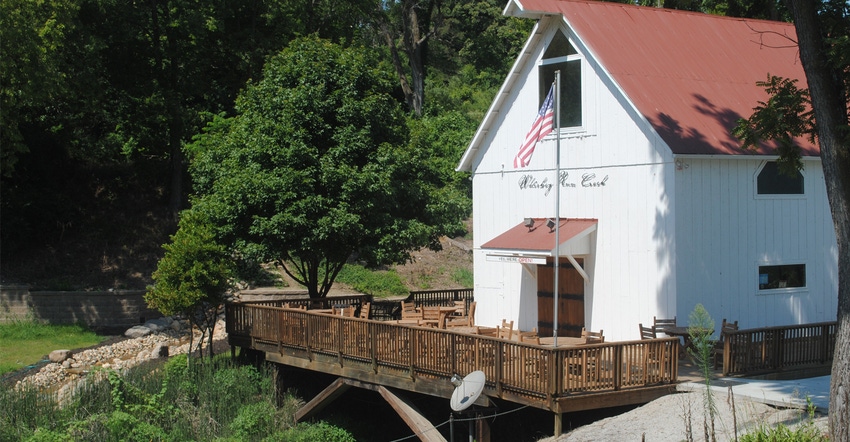
Ron and Sherry Heskett were farming traditional crops, but now they own and operate a vineyard, winery and distillery. While the transition from conventional farming to the vineyard business may be quite a leap, there are many aspects of the winery business that the Hesketts find refreshing.
Ron had graduated from the University of Nebraska with a degree in agriculture and returned home after college to his family's farm south of Brownville, Neb. At the time, he probably never dreamed that his family would one day own a vineyard.
Today, the owners of Whiskey Run Creek Winery and Distillery on the west edge of Brownville enjoy their unique agriculture enterprise. "One of my favorite things about this business is meeting all the people that come through the door for wine tasting, from all over the world," Ron Heskett says. "I didn't get to do that when I was working the cornfields on the tractor."
The family's move into viticulture and the winery business happened over the course of many years. Now, their son Matthew is joining the business. They planted 900 new vines this past year, taking the vine count up to 5,000 on their farm.
In addition, the family built a new distillery in 2017 and produced its first vodka in 2018. Over time, they hope to process and market an apple brandy, as well as rum and whiskey — true to the vineyard's name.
Breaking from tradition
As a fifth-generation farmer, Ron Heskett was farming traditional crops when he attended a few workshops from the Southeast Nebraska Alternative Crops Association. "One of the enterprises the group was looking at was grapes," he recalls. "So, I planted a few grapes in 2000. We did eight rows, which was 640 vines." By 2002, they had grapes to sell.
At that time, Bob Curttright was building up his winery in Brownville. Curttright had the opportunity to buy his family's farm south of Brownville after retirement. "Bob read an article about the University of Nebraska looking for sites for test plots for vineyards," Heskett says. "With help from Paul Read at UNL, a test plot was planted on Bob's farm in 1998. Then he planted more grapes in 1999."
The suggestion was made to Bob to consider building a winery. "Bob did the research and found the spot on the Whiskey Run Creek in Brownville," Heskett says. Curttright chose an historic location in Brownville that was the site of one of the first breweries in Nebraska.
A cave on the site, which since has been restored to past glory, was built in 1866 for storing barrels of beer. Curttright found an old barn south of Auburn, Neb., and had it moved onto the site — on a foundation that had been constructed across Whiskey Run Creek. So, when the winery barn was set down in its new location in Brownville, it spans the creek. It is the only winery that can say that a creek runs through it.
"I had some grapes back in the early years and went to Bob to sell them," Heskett recalls. "I started helping Bob out. One day, he asked if I'd like to make the wine."
During this time, Heskett began to move away from traditional farming. He planted his last row crops on his farm in 2004. "Just as the winery was really getting built up, Bob got sick," Heskett says. "When he passed away in June of 2007, we just kept the winery going for the family." In 2012, Ron and Sherry purchased the winery and have operated it ever since.
"When we started, we planted several different grape varieties, using UNL recommendations," Heskett says. "Grapes love drought, and they don't like a lot of wet weather like we've had this year."
He notes that disease can be a big problem for a vineyard, especially in wet years. "A lot of vineyards also have problems with pesticide drift, but that hasn't been a major problem for us so far," he adds.
Over time, the family found varieties that worked best for their soils. "We started building a trellis system that consisted of a double cordon or fruiting wires, and we changed that after three or four years," Heskett says. "We now use a vertical shoot position, or VSP, trellis system for most of our vines."
In this kind of system, vine shoots are trained upward in a vertical, narrow curtain with a fruiting zone below. The cordon, or fruiting wire, is a few feet off the surface, and catch wires above the cordon are used to train shoot growth in an upward direction.
Plans for expansion
"The biggest challenge for us is marketing," Heskett says. "It would be great if we could sell all of our products out our door, but that just isn't the case." This past summer, with local flooding and bridge repair issues slowing normal tourist traffic into the region, it has been much slower than normal at the winery.
Heskett and the family remain excited about the prospects of more grapes in the vineyard and a new distillery, along with the new distillery products that could bring on a new market from their enterprise.
"This is the 25th anniversary of the wine industry in Nebraska," Heskett says. "Nebraska's wine industry has come a long way in that time, and Nebraska wineries are producing some outstanding wines."
Get more details on Whiskey Run Creek Winery and Distillery at whiskeyruncreek.com.
About the Author(s)
You May Also Like






